| URLs in this document have been updated. Links enclosed in {curly brackets} have been changed. If a replacement link was located, the new URL was added and the link is active; if a new site could not be identified, the broken link was removed. |
Browsing of E-Journals by Engineering Faculty
Engineering Librarian
denise@uflib.ufl.edu
Engineering Librarian
abuhler@ufl.edu
University of Florida
Marston Science Library
Gainesville, Florida
Abstract
In response to a hypothesis that researchers who no longer use print journals may miss out on the serendipitous benefits of "poor indexing" provided by print tables of contents, librarians at the University of Florida surveyed their engineering faculty to determine faculty use of tables of contents in either print or online format. Results indicate that the engineering faculty still use tables of contents and journal browsing to support current awareness and other information-seeking needs. Respondents rely heavily on library-subscribed databases and they still pay attention to the journal name when reading articles. Differences in behavior across academic ranks and engineering subdisciplines are apparent. Associate Professors browse less and are less confident that they are keeping up than Assistant Professors or Professors. The survey results also support a trend of relying more on the interpersonal network that is carefully built by researchers as their careers progress.
Introduction
While hypothesizing that the recent pattern of citing fewer and more recent articles is due to the easier identification of key relevant articles rather than due to an inclination to read only articles available online, Evans (2008) asserts: "This research ironically intimates that one of the chief values of print library research is poor indexing. Poor indexing--indexing by titles and authors, primarily within core journals--likely had unintended consequences that assisted the integration of science and scholarship" (p.398).
Evans implies that researchers no longer use the "poor indexing" technique of browsing tables of contents from journals. However, the technique of scanning "poor indexing" remains available in the online environment through a continued use of tables of contents (ToC) as a first-level notification of publication. Researchers may subscribe to ToC services, via e-mail or RSS feeds. Readers who open a journal article by drilling through the journal's home page to the issue and article have the opportunity to view ToC on their journey.
We tested the assertion that "poor indexing" through ToC is no longer used among our Engineering faculty. To what extent do faculty receive and skim ToC from their favorite journals, thus imitating the print practice of keeping up with the full range of articles from key or favorite titles? If they rely less on ToC, do faculty still value the coherence of a journal title, or are they highly focused on links to isolated articles? We chose to assess browsing and skimming behaviors through a survey instrument.
Selected Literature Review
In addition to Evans' work, other research examines the differences in retrieval, selection, and citation practices in the e-journal environment based on search vs. browse techniques. Following are relevant highlights from these studies.
Three key review articles in electronic journal user behavior include Tenopir's (2003) review of major and small-scale studies published between 1995 and 2003. One conclusion from these early studies indicates that "Browsing a small number of core journals is important (in print or electronic forms), especially for subject experts and for current awareness searching." Rowlands (2007) continues a review of research published between 2003 and 2007. He considers his conclusions provisional due to limitations of the research studied, but he notes a shift in focus from journals to items; a shift from mostly browsing towards more searching behaviors; and a use of "coping strategies" to compensate for inadequate searching skills (p. 390-1). Tenopir et al. (2009a) tracked article reading patterns over 30 years. While summarizing the team's findings across several studies, they conclude that "Scientists report reading a higher proportion of older articles from a wider range of journal titles and more articles from library e-collections."
Documentation of shifts in individual behavior is less common. Hemminger et al. (2007) conducted a large survey that notes a trend toward preferring to search and browse online, but did not query differences between those behaviors. Inger and Gardner (2008) studied navigation in 2005 and 2008 to inform publishers about web site design and concluded, "The most highly sought-after features of journal web sites are content alerting services, but not personalisation and not search functions." Both the 2005 and 2008 surveys were sent to ToC subscribers, so the results are expected to show a stronger preference for ToC use than surveys of broader audiences. E-mail alerts and journal home pages remained the two favorite methods for viewing the latest issues of core journals in 2008 as they had in 2005; with a subtle gain in preference for homepages and reduction in alerts in the three years.
The Boyce et al. (2004) survey results highlight the differences across disciplines but indicates a continuing role for browsing: "In addition, browsing remains important in journal titles considered to be core to an individual's work, and is especially important for current awareness reading of current issues" (p. 124). Eason et al. (2000) reported that, among the browsing functions used by survey respondents, the most heavily-used was the ToC (Table 2). The extent to which ToC are still scanned as they were in 2000, or reduced as claimed by Evans (2008) is the question of interest. A deep log analysis of OhioLINK activity to study the age of retrieved articles indicated, "...those just viewing an issue (table of contents) page were far more likely to be current awareness 'checkers' as nearly half the views related to the current period [i.e., same year], as was true for only 24% of those viewing an issue page but also going on to view an article or abstract." (Huntington et al. 2006, p1849). Although ToC viewing is not reported as a percentage of activity, one presumes the function was used frequently enough to have the inference drawn.
Nicholas et al. (2008), Tenopir et al. (2009b), and King et al. (2009) are examples of studies that examine differences in browsing/searching behaviors across broad groupings of academic departments, but do not specify engineering subdisciplines. Nicholas et al. (2006) observed, through deep-log analysis, that searching behavior led to researchers citing a wider range of articles than those who limit to current awareness browsing of ToC. A similarly-composed team (Nicholas et al. 2007) used deep log analysis to study use of abstracts. They note a limitation to deep-log analysis in not indicating motivation for behavior, such as current awareness or true browsing or following a path to known-item retrieval. They also report that abstracts were still being viewed significantly, noting an increase in use of abstracts with the age of the viewer -- speculating that experienced researchers may have learned how to use abstract content effectively. Rowlands (2007) notes that age and academic status are often considered to be predictors of scholarly information-seeking behavior, but acknowledges a lack of "systematic base of evidence" (p. 391). A review by University College London (2008) concludes that correlating searching and browsing patterns with age may not yet be valid. Responses to the Tenopir et al. (2009b) surveys indicate that older faculty rely more on browsing and less on searching to identify articles worth reading, without attributing the differences to any motivating factors such as comfort with searching or intended purpose such as current awareness or research. We intend to contribute to the correlation of academic status, which is loosely coupled with age, with browsing behavior.
Tenopir et al. (2009a) asked their 2005 respondents to indicate how they learn about articles for different purposes. The browsing and searching percentages for research purposes were 29.9% and 31.6%; for teaching purposes, 43.7% and 25.8%; and for current awareness purposes, 61.4% and 12.5% (Table V.). These percentages indicate that, as of 2005, researchers continued to rely heavily on some form of browsing (whether ToC-based or otherwise) to keep themselves current on new publications in their fields of interest. Additional work by Tenopir et al. (2009b) analyzed factors that influence articles read completely, and not just identified or skimmed. For many questions, respondents were asked to focus on the latest scholarly article read rather than their range of current practices. Engineering /technology faculty are the second highest (after medical/health faculty) in the number of articles read, lowest among disciplines in percent of articles read for current awareness purposes, highest in obtaining articles from the open Web and colleagues and "other" sources, and the only discipline to report becoming aware of articles that merit reading more frequently through searching (32.8% of the time) than browsing (30.5%). That engineering faculty report the highest proportion of searching to browsing activity is especially interesting in view of Rowlands' (2007) observation that many use "coping strategies" to compensate for lack of searching skills; perhaps engineering faculty are more comfortable and confident in searching techniques due to their training and mindset.
Method
A survey invitation was sent to all Engineering faculty at the University of Florida, asking them to compare their current and past practices in e-journal use. From a pool of approximately 379 faculty, 74 (20%) responded. Not every respondent answered every question.
Hypotheses tested via the survey responses included:
- Engineering faculty still use ToC and journal browsing to support current awareness and other information-seeking needs.
- Engineering faculty still pay attention to journal name.
- Patterns in e-journal use across engineering departments are apparent.
Local E-Journal Use
Engineering faculty at UF have online access to most of their current journals. All subscribed titles published by Elsevier/ScienceDirect, Wiley, and Springer are online since at least the late 1990s. Subscribed titles published by ASCE, ASME, ACS, IEEE/IEL, AIP, APS, IoP, etc. are also available online. Titles from these core publishers are no longer received in print. Since 2000, one-time funds have been used (when available) to purchase backfiles from commercial and society publishers. Since more than 90% of engineering-related journals currently subscribed at UF are available online, and no longer received in print, the survey questions did not need to account for differences in print vs. online availability, and therefore browsing-related behaviors, for all engineers or for subdisciplines within engineering.
Results
Following are the overall total or percentage responses to each of the survey questions. In all cases, results are further analyzed by the academic ranks of Assistant Professors, Associate Professors, and Professors. Due to a small number of respondents in each of the miscellaneous academic ranks, their results were not further analyzed by rank. Results are also analyzed by the academic departments within engineering where patterns emerged. The Appendix lists the full form of questions asked, the response options, and number of total responses.
Q1 & Q2. What is your department? & What is your academic rank?
See Appendix for full department names.
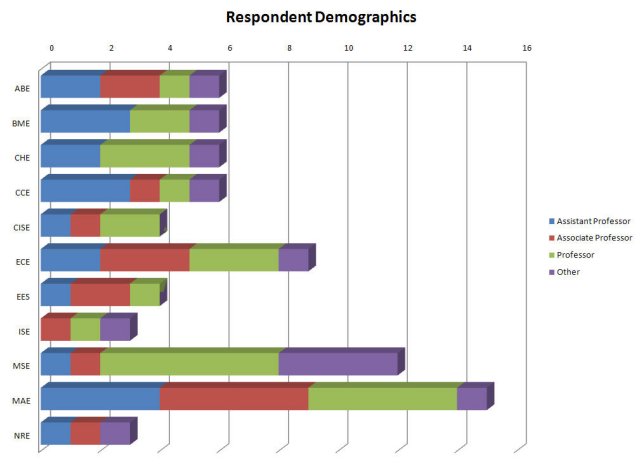
Although the overall response rate was disappointing, the 22% rate of return among tenured and tenure-tack faculty at UF (Khargonekar 2009) is gratifyingly higher than that of the non-tenured ranks (13%). Thirty percent of the Assistant Professors, 19% of the Associate Professors, and 25% of the Professors responded.
Q3. How frequently do you skim/browse ToC?
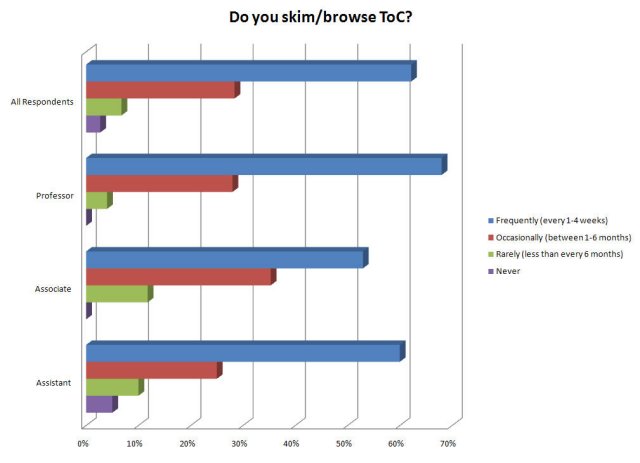
A heartening 62% of all respondents browse ToC "frequently," and 28% browse "occasionally." Five total respondents "rarely" browse ToC and only two claim to "never" browse ToC. Fewer Associate Professors report "frequently" (53%) than do Assistant (60%) and Full Professors (68%). None of the respondents in Computer & Information Science & Engineering and only 33% in Electrical & Computer Engineering report "frequently" browsing ToC, prompting us to speculate that this group is most comfortable with database searching and thus less inclined to browse ToC.
Q4. How do you skim/browse?
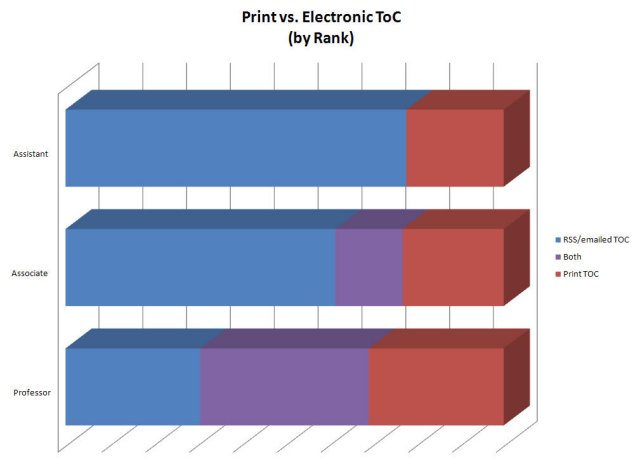
The most popular single method is to "go to the publisher/journal web site" (59% of respondents); however, the total using ToC in either print or online format tops the list with 67%. Thirty eight percent review articles in a journal issue when linking to a single article and 13% use search engines or other web sources. Associate Professors indicated a much greater use of RSS/e-mailed ToC (59%) than Assistants (41%) and Full Professors (38%). Full Professors and Assistants report a much higher activity of browsing on publisher web sites (67% and 65%) than Associates (41%). Perhaps Associate Professors are the group most focused on a particular research niche, or more confident of their place in their field, or simply don't have the time to browse. Not surprisingly, the use of print ToC and the ratio of print to all electronic methods of ToC are proportional with rank: 12% of Assistants, 29% of Associates, and 38% of Full Professors skim print ToC. None of the Assistants, 15% of the Associates and 38% of the Professors who rely on ToC use both print and online ToC services. Eighty-three percent of Biomedical Engineering respondents reported use of online ToC while 50% of Environmental Engineering Sciences favored print ToC.
Q5. Have your practices changed with the availability of e-journals?
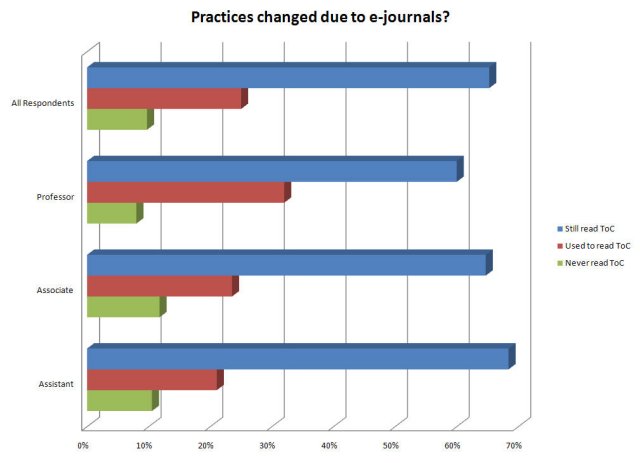
This question was intended to gauge faculty awareness of the change in their behavior. The response differences are subtle but apparent across the ranks. Assistant Professors report the highest level of "still" reading titles of articles in favorite journals (68%) and the lowest level of admitting change (21%). The reverse is true of Full Professors, with 60% reporting "still" and 32% "used to." Associates closely match the averages among all respondents. These results are expected; those longest in the profession have changed their behavior as articles proliferated and e-journals became available. The results also demonstrate that even with this proliferation of e-journals, the ToC remains an important device for information gathering. The departments with the highest percentage reporting "used to" (50%) are Chemical Engineering and Computer & Information Science & Engineering. Only 10% of respondents admit to "never" paying attention to articles other that the ones they intend to read, indicating that most respondents show a healthy interest in research beyond their individual focus.
Q6. What other methods do you use for keeping up with current literature?
Respondents selected all the methods they use. The most frequently-used methods across ranks are searching databases (84% of respondents selected this as one of their methods), conference attendance and connections outside the university (76%), and links within other articles (73%). Full Professors rely more on interpersonal communication through conference attendance and connections outside the university (92% compared to 76% and 75%). Assistant Professors rely most on searching databases (95% compared to 88% and 72%) and links within other articles (80% compared to 76% and 68%), perhaps reflecting both the early development of their interpersonal networks and their greater comfort with online resources. Faculty in Computer & Information Science & Engineering use blogs and e-mail discussion lists more than other departments for keeping current.
Q7. How confident are you that you're keeping aware?
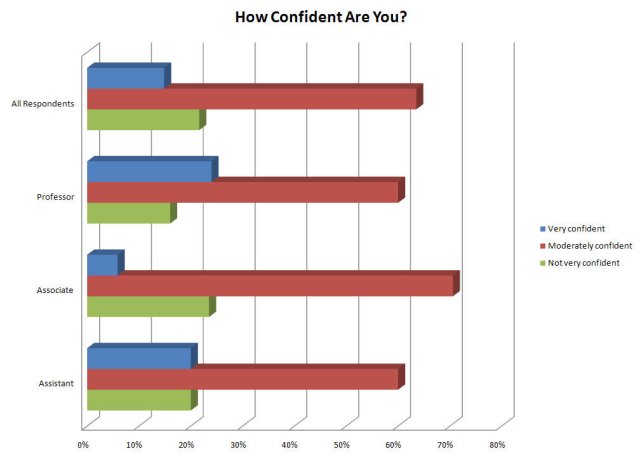
A similar question was asked by Hemminger et al. (2007, Table 10) but the responses were based on a 5-point scale and range from 3% "very not confident" through 10%, 27%, 49%, and finally 10% "very confident." Results across the surveys are not directly comparable.
Associate Professors appear to be the most aware of what they're missing. Associates were substantially less likely to respond "very confident" (6%) than the other ranks (20% for Assistants and 24% for Full Professors), and more likely than the others to respond "not very confident" (23% compared to 20% and 16%). Associates are also less likely to browse (Q4) than the other ranks. Among departments, the Agricultural & Biological Engineers appeared the least confident with 67% feeling "not very." All respondents (100%) in Computer & Information Science & Engineering, Environmental Engineering Sciences, and Industrial & Systems Engineering claim at least moderate confidence.
Q8. Do you pay attention to the journal name?
Nearly 80% of the respondents claim "always," and the rate is close to average across the ranks. Newer faculty do not appear to pay any less attention to journal names than do the veteran faculty. No ranks or departments had a rate below 50% in reporting to "always" pay attention. All of the respondents (100%) from Chemical Engineering, Electrical & Computer Engineering, and Industrial & Systems Engineering claimed "always." The least attention is paid in Agricultural & Biological Engineering (only 50% "always," 17% "sometimes," and 33% "rarely") followed by Computer & Information Science & Engineering (only 50% "always," 25% "sometimes," and 25% "rarely").
Q9. Which publisher graphics do you notice?
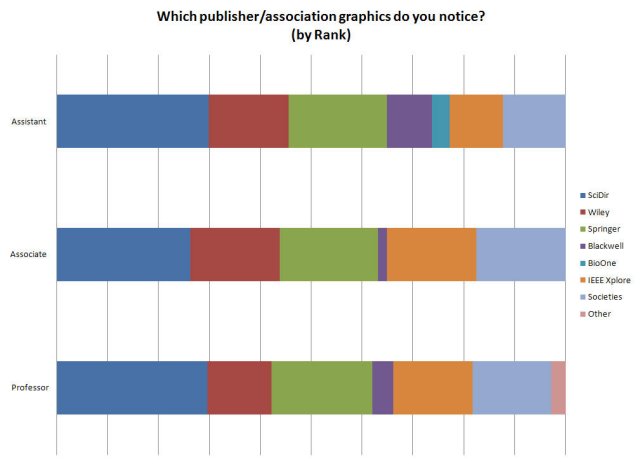
The clear winner is ScienceDirect (Elsevier), recognized by a whopping 85% of all respondents, which scored (or tied for) the highest logo recognition in each rank and in each department except Electrical & Computer Engineering, where it scored second only to IEEE Xplore. IEEE Xplore tied ScienceDirect among the Nuclear & Radiological Engineering respondents, and placed third in Computer & Information Science & Engineering. BioOne was recognized only by Assistant Professor respondents in the areas of Agricultural & Biological Engineering and Biomedical Engineering. Only 5 respondents did not credit any logos with recognition: 3 Assistants, 1 Professor, and 1 Professor Emeritus. Only Professors listed "other" publishers. The higher percentage of Assistants not claiming to recognize logos may be indicating a trend among newer researchers toward placing less value on the journal or publisher name.
Q10. Do you teach your grad students to look for or to value key journals in your field?
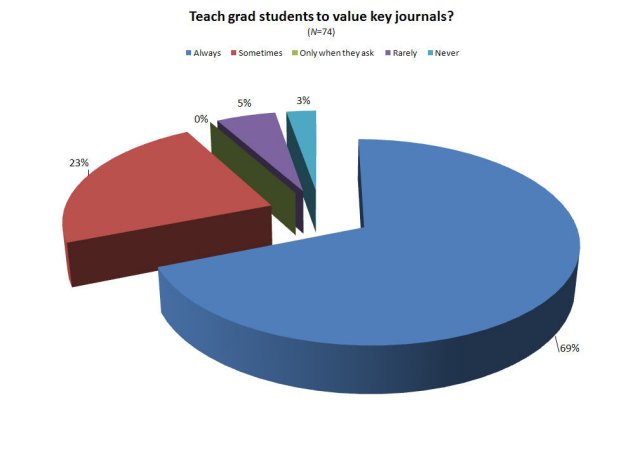
Among all respondents, 69% claim "always" and another 23% report "sometimes." Only one brave Associate Professor and one Adjunct admitted "never." The percentages do not vary much among the academic ranks. Departmental differences are apparent; Industrial & Systems Engineering faculty report 100% "always" while Computer & Information Science & Engineering, a discipline that relies heavily on conference proceedings and preprints, and Chemical Engineering both claim a low of 50% "always."
Q11. How do you find specific journal articles?
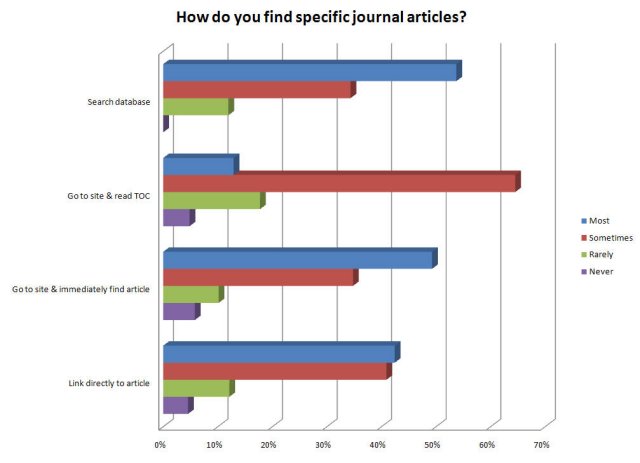
The method scoring the greatest number of "most" votes is searching a favorite database (by 54% of respondents), followed closely by going to a journal site and immediately finding the article (49%) and linking directly to the article (42%). The methods used "sometimes" include going to the journal web site and observing other articles (64%), followed by linking directly to the article (41%), going to a journal site and immediately finding the article (35%), and searching a favorite database (34%). "Linking directly to the article" was selected as "most" by more Professors (55%) than Associates (40%) or Assistants (26%). "Going to a journal site and immediately finding the article" is more favored by Associates (56%) than Professors (48%) or Assistants (42%). "Searching a database" is more favored by Assistants (58%) than Associates (56%) or Professors (48%). "Going to the journal web site and observing other articles" is not a very common practice across all ranks with only 20% of Associates, 11% of Assistants, and 10% of Professors choosing this as their most used option. The "favorite database" response included Google Scholar among the hints of library-subscribed databases rather than breaking out Google Scholar and Google as a separate category. Our intent was to measure browsing vs. searching behavior, but in hindsight we would have liked to measure library-subscribed databases separately from the free databases.
Q12. When you look for articles on a topic, where do you start?
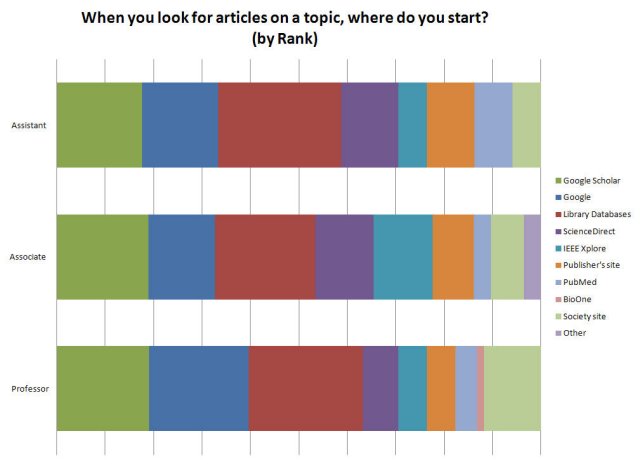
Library-subscribed databases are claimed to be used most frequently (by 69% of all respondents), followed by Google Scholar or Google (68%), Google Scholar (53%), Google (50%), and ScienceDirect (28%). The number of respondents selecting both Google Scholar and Google (23) is nearly twice that of respondents selecting only one of those databases (13 for Google Scholar only and 12 Google only). We deliberately placed Google Scholar ahead of Google in the response options to encourage respondents to think of the indexes separately, and the strategy appears to have worked successfully. Preference for library databases is strongest among respondents in Agricultural and Biological Engineering, Environmental Engineering Sciences, and Nuclear & Radiological Engineering with 100% of respondents choosing the option. The next highest use of library databases is among respondents in Chemical Engineering, Civil & Coastal Engineering, and Materials Science & Engineering with 83% selecting the choice. The Industrial & Systems Engineers reported no use of library databases, but all use Google/Google Scholar. All respondents in Electrical & Computer Engineering and Computer & Information Science & Engineering use Google/Google Scholar. These subdisciplines rely heavily on journal titles (such as IEEE and ACM), technical reports, and conference papers that are well indexed in Google/Google Scholar. The lowest use of Google/Google Scholar is among respondents in Environmental Engineering Sciences and Nuclear & Radiological Engineering, all of whom use library databases. Among all respondents, 14% mentioned PubMed, reflecting the trend of engineers to direct their research projects toward medically-related applications.
Q13. Any other comments on tracking your favorite journals or keeping up with articles in your field?
Two of the 14 related comments indicate that our engineering faculty rely on "web sites of colleagues and other researchers" as one method for keeping current. We plan to track whether this is reported as a more popular choice in the future, as social networking functions impact the knowledge-sharing process (Cope and Kalantzis 2009). Only two respondents included their e-mails for follow-up; not surprisingly, the respondents who seemed to indicate that they are unfamiliar with library services (such as Interlibrary Loan or remote access methods) did not include their e-mails so we were unable to contact them with service options.
Survey Conclusions
The proposed hypotheses have been supported by the data:
1) Engineering faculty still use ToC and journal browsing to support current awareness and other information-seeking needs.
Valid: We have demonstrated that browsing techniques are still used by UF engineering faculty, in spite of Evans' (2008) assertion to the contrary. While a majority of their engineering journal titles are available online, 90% of the respondents indicate a skimming activity in 2009. Some 62% of all respondents continue to browse ToC "frequently" as one method of keeping up with the literature in their field, whether in print or online format, and 28% browse "occasionally." In addition, 84% search databases as a method for keeping up with current literature, so both browsing and searching functions are used by UF engineering faculty.
2) Engineering faculty still pay attention to journal name.
Valid: 77% of the respondents claim to "always" pay attention to the journal name. In addition, 85% notice the ScienceDirect publisher's logo. Only 6.8% of respondents did not credit any logos with recognition. The "container," whether journal name or logo, remains noted by our engineering faculty. Our data set indicates a trend among Assistant Professors for noting the publisher logo less frequently than their more experienced colleagues, and this trend deserves to be monitored closely over time.
3) Patterns of use among engineering departments are apparent.
Valid: As discussed in the results above, departmental differences appeared in several behaviors: the use of print and online ToC, changes in browsing practice, methods of keeping up, confidence in keeping up, attention to journal name and publisher graphics, teaching graduate students to pay attention to journal names, and use of library databases. The patterns appear consistent with the general use of format (journal articles, conference papers, technical reports) and quality and availability of indexing services across the subdisciplines.
The results show some distinct patterns across the academic ranks of Assistant Professors, Associate Professors, and Professors. We would have liked to correlate the age of respondents with their activities, but settled instead for an assumption of general correlation of age, experience or habit, and academic rank. Perhaps rank is as strong an indicator of browsing behavior as age, since faculty of the same rank are engaged in similar research behaviors. We speculate that early-career Assistant Professors are still finessing their research focus and assessing the place of their research within the discipline. Mid-career Associate Professors are the most likely to have highly-focused research interests and to be aware of related work conducted by others. Our Associate Professors browse less (Q4) and are less confident they are "keeping up" (Q7) than the other ranks, prompting us to speculate that the narrowed research focus of this group may also contribute to a lack of time to devote to the current awareness chore. Late-career Professors are more likely to acknowledge the universe of research beyond their core of awareness. Our results support the data presented by Tenopir et al. (2009b) on several points: browsing is used more frequently by Professors, then by Assistants, and least by Associates; corresponding with the Tenopir et al. data (2009b, table 22) that browsing is used most by the 51+ age range and least by 31-40 year olds. Searching activity is inversely proportional to age or academic rank in both surveys. Results from both surveys also support a trend of relying more on colleagues and the interpersonal network that is carefully built by researchers as their careers progress.
Future Research and Next Steps
We are planning to send a similar survey to engineering graduate students. The survey may be sent to other sci-tech colleges and departments on campus.
Improvements to the survey instrument include:
- Devise strategies to improve the response rate. Might engineering faculty respond better to shorter surveys sent out more frequently? Might graduate students respond better if given a small treat or an option to be entered in a drawing for a more valuable prize?
- For faculty: ask age (in 5-year ranges) as well as rank.
- For graduate students: Instead of academic rank, ask age and in which year of the program they are engaged, to enable drawing correlations within these variables. A graduate student survey may show us how our future faculty will behave, and how we need to adjust to accommodate their changes in journal browsing and other behaviors.
- Repeat the survey at 5-year intervals to catch changes due to age/stage in profession vs. changes due to a real shift in overall behavior, including search as well as browse activities.
- Rework Q11 to separate library-subscribed databases from Google/Google Scholar. Consider how databases that are free but library-like, such as arXiv, CiteSeer, and NASA NTRS, should be categorized among the options.
- Supply more options for publishers and databases in Q9 and Q12. Although longer lists of choices may seem confusing, the range of "other" responses indicates that more options may be useful for our population.
- Include "web sites/blogs of colleagues and other researchers" as an option for keeping current. This behavior was mentioned in two open-ended comments.
- Consider the timing for another survey asking faculty which journal titles they value. A collection analysis survey should probably be distributed separately from a current awareness behavior survey.
The survey results also indicate some next steps to guide the engineering librarians in communicating with their faculty:
- We must continue to communicate with our faculty about services that may be less obvious to them, such as remote access methods and ILL.
- The different responses by faculty across departments indicate that our subject liaisons may see opportunities for serving those audiences more distinctly by tailoring services and communication methods based on departmental preferences. A specific example from Q7 is to publicize current awareness options to those who are less confident that they are keeping up with articles in their field.
- Since many of our faculty use Google Scholar, we must regularly communicate the value to them in configuring our link resolver in all of the web browsers that they use.
- We were surprised to receive no suggestions through this survey instrument that we add specific journal titles to our collection. In 25 years of prior surveys to our faculty on any library-related topic, our faculty have never failed to include journal requests (whether to titles we do or do not own). Perhaps our recent collection streamlining decisions have served our faculty well.
References
Boyce, P.D., King, W., Montgomery, C. & Tenopir, C. 2004. How electronic journals are changing patterns of use. Serials Librarian 46:121-141.
Cope, B. and Kalantzis, M. 2009. Signs of epistemic disruption: transformations in the knowledge system of the academic journal. First Monday 14(4-6). [Internet]. [Cited May 6, 2010]. Available from: http://firstmonday.org/htbin/cgiwrap/bin/ojs/index.php/fm/article/viewArticle/2309.
Eason, K., Yu, L.Z. & Harker, S. 2000. The use and usefulness of functions in electronic journals: the experience of the SuperJournal project, Program (2000):1-34.
Evans, J.A. 2008. Electronic publication and the narrowing of science and scholarship. Science 321(5887):395-9.
Hemminger, B.M., Lu, D., Vaughan, K.T.L. & Adams, S.J. 2007. Information seeking behavior of academic scientists. Journal of the American Society for Information Science and Technology 58(14):2205-25.
Huntington, P., Nicholas, D. & Jamali, H.R. 2006. Article decay in the digital environment: An analysis of usage of OhioLINK by date of publication, employing deep log methods. Journal of the American Society for Information Science and Technology 57(13):1840-51.
Inger, S. & Gardner, T. 2008. How Readers Navigate to Scholarly Content: Comparing the Changing User Behaviour Between 2005 and 2008 and Its Impact on Publisher Web Site Design and Function. 1-32.Available at: {http://www.marywaltham.com/howreadersnavigatetoscholarlycontent_oCT_08.pdf}.
Khargonekar, P.P. 2009. State of the College. Presentation to the Dean's Advisory Board, University of Florida's College of Engineering, April 2009. [Internet]. [Cited May 6, 2010]. Available from: {https://www.eng.ufl.edu/ppk/documents/presentations/stateofthecollege_2009.pdf}
King D.W., Tenopir, C., Choemprayong S. & Wu L. 2009. Scholarly journal information-seeking and reading patterns of faculty at five US universities. Learned Publishing 22(2): 126-144.
Nicholas, D., Huntington, P., Jamali, H.R. & Tenopir, C. 2006. Finding information in (very large) digital libraries: a deep log approach to determining differences in use according to method of access. Journal of Academic Librarianship 32(2):119-26.
Nicholas, D., Huntington, P. & Jamali, H.R. 2007. The use, users, and role of abstracts in the digital scholarly environment. Journal of Academic Librarianship 33(4): 446-53.
Nicholas, D., Huntington, P., & Jamali, H.R. 2008. User diversity: as demonstrated by deep log analysis. Electronic Library 26(1):21-38.
Rowlands, I. 2007. Electronic journals and user behavior: A review of recent research. Library & Information Science Research 29(3):369-96.
Tenopir, C. 2003. Use and Users of Electronic Library Resources: An Overview and Analysis of Recent Research Studies. Washington, DC: Council on Library and Information Resources., pub 120. [Internet]. [Cited May 6, 2010]. Available from: http://www.clir.org/pubs/abstract/pub120abst.html
Tenopir, C., King, D.W., Edwards, S. & Wu, L. 2009a. Electronic journals and changes in scholarly article seeking and reading patterns. Aslib Proceedings 61(1): 5-32.
Tenopir, C., King, D.W., Spencer, J. & Wu, L. 2009b. Variations in article seeking and reading patterns of academics: what makes a difference? Library & Information Science Research 31: 139-148.
University College London. 2008. Information Behaviour of the Researcher of the Future. [Internet]. [Cited May 6, 2010]. Available from: {https://web.archive.org/web/20080822030206/http://www.bl.uk/news/pdf/googlegen.pdf}
Appendix
The Survey
Appendix (PDF)
| Previous | Contents | Next |
